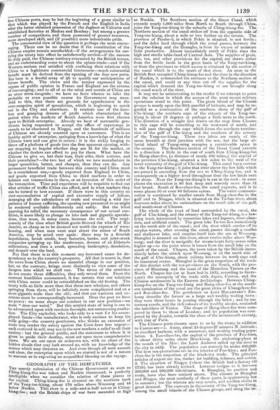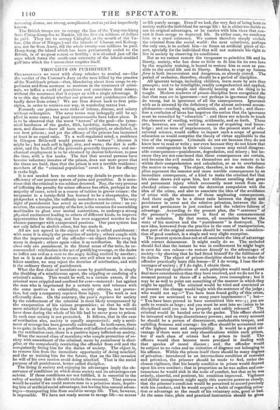GEOGRAPHY OF THE DESPATCHES.
The speedy submission of the Chinese Government as soon as Ching-kiang-foo was taken and Nankin threatened, is perfectly intelligible when we consider the relation of these places to the capital. Ching-kiang-foo is situated on the southern bank of the Yang-tse-kiang, about 170 miles above Woosung and 48 below Nankin. This river is a mile-and-a-half across at Ching- kiang-lbe ; and the British ships of war have ascended as high
as Nankin. The Southern section of the Great Canal, which extends nearly 1,000 miles from North to South through China, Joins the Yang-tse-kiang in the suburbs of Ching-kiang-foo. The Northern section of the canal strikes off from the opposite side of Yang-tse-kiang, about a mile or two further up the stream. The province of Petshe-hi, in which Pekin is situated, is not fertile ; and the delta land through which the canal passes, between the Yang-the-kiting and the Hoangho, is from its excess of moisture little productive. Almost immediately north of Pekin rises the high and sterile table-land of Central Asia. The supplies of grain, rice, tea, and other provisions for the capital, are drawn either from the fertile lands in the great basin of the Yang-tse-kiang, or from the provinces to which access is obtained by the section of the canal which is to the south of that river. As soon as the British fleet occupied Ching-kiang-foo and the river in the direction of Nankin, it commanded the entrance to the Northern section of the canal, and could at any time cut off the supplies for the capital which descend the Yang-tse-kiang or are brought along the canal south of the river.
It may not be uninteresting to the reader if we attempt to point out the relation in which the scenes of the most recent military operations stand to this point. The great island of the Chusan groupe is nearly upon the 30th parallel of latitude, and may be re- garded as a continuation of the southern shore of the gulf of Che-kiang: the northern cape of the estuary of the Yang-tse- kiang is about 32 degrees or perhaps a little more to the north.
The direction of a straight line drawn on the map from Chusan-
to this cape will be something to the westward of north, and it will pass through the cape which forms the northern termina- tion of the gulf of Che-kiang and the southern of the estuary of the Yang-tse-kiang. These two inlets are nearly of the same breadth at their junction with the sea; but the large al-
luvial island of Tsung-ming occupies a considerable space in
the estuary. The Southern section of the Great Canal extends in a direction a little to the east of south from Ching-kiang-foo to Hang-choo-foo (a distance of nearly 300 miles,) the capital of
the province Che-kiang, situated a few miles to the west of the inner extremity of the gulf of Che-kiang. This canal has a current
to the Yang-tse-kiang; it joins that river above the low hills which are passed in ascending from the sea to Ching-kiang-foo, and is consequently on a higher level throughout than the low lands next the shore. Near the Yang-tse-kiang it is cut in the rock : in some places the excavation is 80 feet deep and scarcely more than 12 feet broad. South of Soo-choo-foo, the canal expands, and is in some places 50 or even 80 fathoms across. The water-communi-
cation is continued by smaller canals from Hang-choo-foo to the gulf and to Ningpc4 which is situated on the Ta-hae river' about fourteen miles above its embouchure on the south side of the gulf; and south-west of Chusan.
The whole of the tract of land surrounded by the canal, the gulf of Che-kiang, and the estuary of the Yang-tse-kiang, is a low- lying tract, intersected by numerous lakes and lagoons, river-chan- nels, and artificial canals. The great lake Ta-too lies immediately on the north side of the canal ; and the river which carries off its surplus waters, after crossing the canal, passes through a smaller and shallower lake, and empties itself into the sea at Woosung. Shanghai is situated on this river, about twelve miles above Woo- sung; and the river is navigable for steam-boats forty-seven miles higher up—to the point where it issues from the small lake on the south of the canal. Chapoo, the town taken by the British imme- diately before the attack upon Woosung, is on the north side of the gulf of Che-kiang, about midway between its north cape and its innermost recess. Shanghai is the great emporium of the trade of this district with the tea-provinces on the South, with the pro- vince of Shantung and the coast of the Mantchoo Tartars on the North. Chapoo has (or at least had in 1832, according to Guys-
LAPS') the monopoly of the trade with Japan, Canton, and the
Chinese settlements in the Eastern Archipelago. Between Ching- kiang-foo on the Yang-tse-kiang and Hang-choo-foo at the south- ern termination of the canal are the great cities of Changchow-foo
and Soo-choo-foo. The gentlemen on Lord MACARTNEY'S Em- bassy describe the former as a large and wealthy trading town :
they were three hours in passing through the latter ; and its nu- merous canals, and the rich colours of its wealthy abodes, reminded the beholders of Venice. The shops of Hang-choo-foo were com-
pared by them to those of London ; and its population was com- pared by the Jesuits, towards the close of the seventeenth century, with that of Paris. The Chinese ports thrown open to us by the treaty in addition to Canton are-1. Amoy, about 24 degrees 27 minutes N. latitude ;
an excellent harbour, with a numerous and wealthy trading popu- lation. 2. Foo-choo-foo, the capital of the province of Foo-kien, is about thirty miles above Hoo-kiang, the anchoring-place at the mouth of the Min : the Lord Amherst sailed up the river to the city in 1832. The population can scarcely be under 400,000. The best tea-plantations are in the interior of Foo-kien ; and Foo- choo-foo is the emporium of the black-tea trade. The principal
articles of export are tea, timber for building, tobacco, and cotton. 3. The situation of Nitigpo (where the British had a factory till 1759) has been already noticed. LINDSAY assigns to it between
200,000 and 300,000 inhabitants. 4. Shanghai, its position and. trade, have also been noticed above. The climate at Shanghai and Ningpo, the most northerly of these ports, is oppressively hot in summer ; but the winters are very severe, and woollen cloths in great demand. The currents in the estuary of the Yang-tee-kiang, among the small islands of the Chusan groupe, and along the in- tervening shores, are strong, complicated, and as yet but imperfectly known.
The British troops are to occupy the line of the Yang-tse-kiang from Ching-kiang-foo to Nankin, till the first six millions of dollars be paid. They are to occupy Chinghai, at the mouth of the Ta- hae, (the river of Ningpo,) and the islands of Chosen and Kolang- soo, not far from Amoy, till the whole twenty-one millions be paid. Hong-kong, the island which has been permanently ceded to the British, is of no great extent or fertility : it is situated just off the cape which forms the south-east extremity of the island-studded gulf into which the Canton river empties itself.



























 Previous page
Previous page